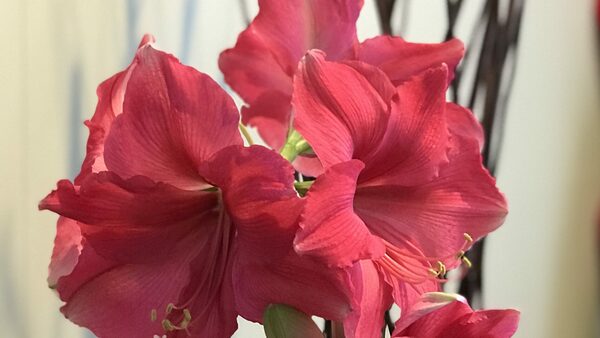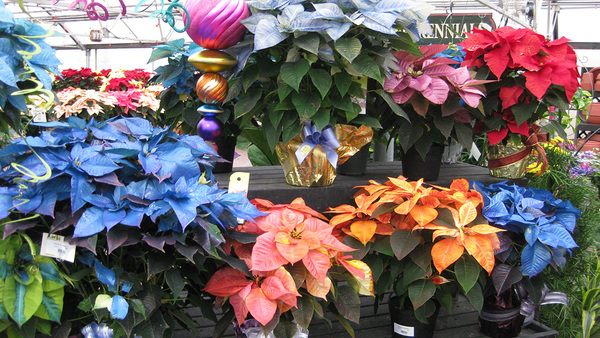
Today Cynthia Strickland, who gardens in Raleigh, North Carolina, is sharing an interesting twist on the familiar amaryllis. (Cynthia has contributed to the GPOD before; check it out here and here.)
In the past weeks I enjoyed watching a “waxed” amaryllis (Hippeastrum hybrid, Zones 7 or 9 through 10 depending on the variety, or grown as a houseplant), a flowering bulb encased in wax, grow and bloom indoors. The flowers lasted at least as long as a cut flower arrangement. It did not need to be planted in soil or watered, and it was easy to move around. The amaryllis only needed bright light, and there was no soil or water to spill.
The roots had been removed, so the bottom of the bulb was flat and free-standing. In some photos you can see how most of the energy goes into flower production and how the length of the leaves are very short. The bulb, which is bigger than a baseball, took about four weeks to produce visible flower buds from under the sepals. In this (unknown) variety, there were two flower stems with four flowers on each stem.
It was interesting to watch the plant parts grow and change, as well as to see how different the red of the petals looked in various lighting situations. The buds grouped together look similar to tulips and really pop next to an ‘Electric Lime’ coleus (Solenostemon ‘Electric Lime’, annual). Outdoors in bright sunlight, the red-orange color is stark and intense paired with a ‘Blue Pacific’ juniper (Juniperus conferta ‘Blue Pacific’, Zones 6–9).
I live in Zone 7a, where I have seen amaryllis growing outdoors. Although the chances are slim that the spent, rootless bulb will continue living, I removed the wax and other covering, sprinkled some rooting hormone on the bottom of the bulb, and placed it in a pot with some soil as an experiment to see if it would grow.
Happy gardening!
 The amaryllis in full bloom.
The amaryllis in full bloom.
 The wax-covered bulb, with the flower buds just beginning to emerge.
The wax-covered bulb, with the flower buds just beginning to emerge.
 The stems beginning to stretch taller.
The stems beginning to stretch taller.





Have a garden you’d like to share?
Have photos to share? We’d love to see your garden, a particular collection of plants you love, or a wonderful garden you had the chance to visit!
To submit, send 5-10 photos to gpod@taunton.com along with some information about the plants in the pictures and where you took the photos. We’d love to hear where you are located, how long you’ve been gardening, successes you are proud of, failures you learned from, hopes for the future, favorite plants, or funny stories from your garden.
If you want to send photos in separate emails to the GPOD email box that is just fine.
Have a mobile phone? Tag your photos on Facebook, Instagram or Twitter with #FineGardening!
You don’t have to be a professional garden photographer – check out our garden photography tips!
Do you receive the GPOD by email yet? Sign up here.
Fine Gardening Recommended Products

Corona E-Grip Trowel
Fine Gardening receives a commission for items purchased through links on this site, including Amazon Associates and other affiliate advertising programs.

Berry & Bird Rabbiting Spade, Trenching Shovel
Fine Gardening receives a commission for items purchased through links on this site, including Amazon Associates and other affiliate advertising programs.

A.M. Leonard Deluxe Soil Knife & Leather Sheath Combo
Fine Gardening receives a commission for items purchased through links on this site, including Amazon Associates and other affiliate advertising programs.


















Comments
Thats very cool. Never seen one grow like that before. And the flowers are beautiful.
Hi, Alice. Thank you for your thoughtful comments! The flowers grew quickly and it was a pleasure to watch their transformation.
I have been growing Amaryllis for several years. This year I gave friends ( who are plant challenged) the waxed Amaryllis bulbs as part of a Christmas gift. They all loved them. But I don't think they will reflower.
Thank you for sharing your experience with Amaryllis!
What varieties have you enjoyed?
Surprisingly the bulbs are resilient and when the wax is removed and potted up continue on normally. Keep it fertilized to put some energy back into the bulb. They might miss a year of bloom but as bulbs can live up to 60 years it's worth keeping them going.
Re: bulbs can live up to 60 years
I did not know that!
And I appreciate your other tips as well.
Wow, that was fascinating! I was given a regular amaryllis bulb in a container this Christmas, and it's just now beginning to sprout. I've never grown one before, but I'm hoping I can keep it blooming over the years. They really are beautiful!
Hi, CostalGardener - I hope you'll be happy with your amaryllis!
Beautiful! Laura from Garden Answer (on YouTube, Facebook and Instagram) did a video about these waxed amaryllis bulbs last year. She potted them all up after removing the wax to keep them growing. I agree it will probably take a year or two for them to be fertilized regularly and build up enough strength before flowering again, but I do believe it is possible.
Also, you can prolong the bloom life of the flowers, as well as enhancing the restoration process of the bulb by cutting the flowers stalks and putting them in a vase.
https://www.hortmag.com/plants/make-amaryllis-flowers-last-longer
Dvngardener - thank you for sharing several sources regarding Amaryllis. I will save those.
Love it! I just got one from my sister for Christmas, and it is just starting it's journey. Love amaryllis!
Enjoy!
I've never seen a waxed bulb. Strange.
Leaving the leaves on until they've completely died back would surely increase the odds that the bulb has enough energy to survive...at least that's how regular bulbs are handled.
good luck with the experiement
Hello - as user-7517271 suggested, a waxed bulb that doesn't need much care and can be discarded after blooming is a way to market and sell amaryllis to people would would not normally buy amaryllis. And because it says on the label to discard after blooming, you essentially have permission to throw away or compost a plant that is not going to be spectacular again for a year or two.
I actually fit into that category of never bought amaryllis and I did not want to care for the bulb indefinitely.
However, I do have the curiosity and space (at the moment) to try the experiment!
I know you have a lot of horticultural experience, so appreciate your comments!
Several of my amaryllis are 5+ years old and seem to want to carry on, even with my benign neglect (I put them outside in the Summer, where they frequently rebloom, and try to remember to put them in a dark cupboard to go dormant before it gets too cold (the cupboard is in the unheated 5b garage). I have never grown a waxed one so will eagerly await your results!
btw - I've started growing Cybister and other evergreen amaryllis that do not require forcing for repeated bloom - my 'La Paz' cybister just finished its first flowering - we'll see how it continues to do as a houseplant. A horticultural friend has a 20yr old 'Papilio' (evergreen) that has increased tenfold!!! For scatterbrained me, the evergreen varieties might be the wave (or petal) of the future!
Musettel - I read through your comments and looked at photos and descriptions of La Paz and Papilio. Thank you!
And I appreciate your sense of humor! :- )
Oh I somehow missed this in my email box...
So much good info here and gorgeous photos!
Log in or create an account to post a comment.
Sign up Log in